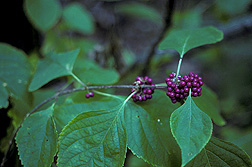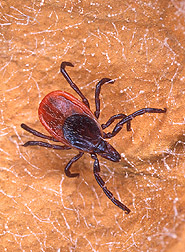This page has been archived and is being provided for reference purposes only. The page is no longer being updated, and therefore, links on the page may be invalid.
|
|
Old-Time Mosquito Remedy May Work Against Ticks, Too
By Luis PonsJanuary 26, 2007
A granddad's wisdom, already helpful in the fight against mosquitoes, may also prove useful in battling disease-spreading ticks.
Last year, Agricultural Research Service (ARS) scientists in Oxford, Miss., isolated compounds from a plant called American beautyberry that enable its crushed leaves to repel mosquitoes.
This work, led by chemist Charles Cantrell at the ARS Natural Products Utilization Research Unit in Oxford, was inspired by a tip another ARS scientist—botanist Charles Bryson in Stoneville, Miss.—got long ago from his grandfather: that beautyberry was used in northeastern Mississippi to protect people and farm-work animals from biting bugs.
Now ARS scientists in Beltsville, Md., have shown that two beautyberry compounds—callicarpenal and intermedeol—may effectively repel blacklegged ticks as well.
Blacklegged ticks are the principal carrier of bacteria that in humans cause Lyme disease, an affliction known for its fevers, headaches and bull's-eye rash. Left untreated, this disease can cause severe and chronic illness.
ARS entomologists John Carroll, in the Animal Parasitic Diseases Laboratory, Beltsville, and Jerome Klun, in the Chemicals Affecting Insect Behavior Laboratory, also in Beltsville, tested the compounds by administering them to cloth strips wrapped around a person's finger in dosages at which the commercial repellent DEET repels ticks.
The treated strips repelled more than 95 percent of blacklegged tick nymphs.
Callicarpenal did especially well in a separate duration test, repelling all the blacklegged ticks tested for three hours after application, and 53 percent after four hours.
The researchers also tested the natural compounds against nymphs of lone star ticks, which transmit potentially serious human diseases known as ehrlichioses.
The two compounds, as well as DEET, were considerably more potent against blacklegged ticks than against lone star ticks. An experimental repellent developed by ARS and known as SS220 was most effective against the lone star variety.
While the findings are preliminary, the beautyberry compounds' usage history leads Carroll to believe that callicarpenal and intermedeol have potential for human use.
ARS is the U.S. Department of Agriculture's chief scientific research agency.


